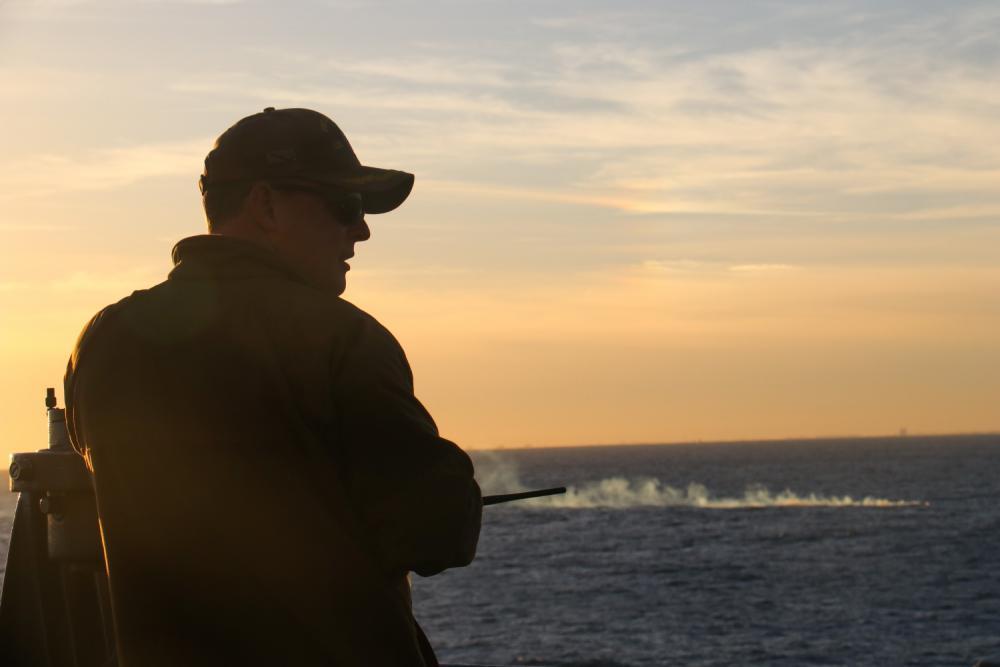
Cmdr. Brad A. Fancher, commanding officer of the dock landing ship USS Carter Hall (LSD 50), observes the debris field of a high-altitude Chinese surveillance balloon shot down by a U.S. Air Force fighter jet over the Atlantic Ocean on Feb. 4.
Before shooting at a Chinese spy balloon from 58,000 ft. on Feb. 4, mission planners were not aware of an F-22 having ever fired an AIM-9X Sidewinder at any target at that altitude similar to the 200-ft.-tall balloon drifting over the Atlantic Ocean, a defense official says.
Gen. Glen VanHerck, commander of U.S. Northern Command (NORTHCOM) and North American Aerospace Defense Command, said they decided to use the missile over others, such as the AIM-120 Advanced Medium Range Air-to-Air Missile, so the Raptor could be at a closer range and the Sidewinder’s much smaller warhead would limit damage to the balloon.
“We assess from an effectiveness standpoint that it was going to be highly effective and that was proven on Saturday,” VanHerck told reporters.
Pentagon and White House officials are sharing more details about the balloon as an effort continues to collect debris from a large swatch of ocean near South Carolina. VanHerck said the large balloon had a structure about the size of an Embraer Regional Jet under it. Officials planned to down it over water to limit the damage from thousands of pounds of components such as large solar arrays, batteries, glass and other hazardous materials.
National Security Council spokesman John Kirby told reporters Feb. 6 that the balloon had propellers and a rudder, which allowed it to change course and conduct limited maneuvers, though it mostly stayed with the jet stream. It was able to slow down and loiter over sensitive locations, he said.
As the balloon traversed the continental U.S., the North American Aerospace Defense Command (NORAD) scrambled intelligence-gathering aircraft to monitor it, including the electronic transmissions coming from the structure. VanHerck would not specify the type of aircraft that responded, though open source flight tracking websites spotted an RC-135U Combat Sent and RC-135R/T Rivet Joints along the balloon’s path. He said NORAD worked closely with U.S. Strategic Command at Offutt AFB, Nebraska, to monitor the balloon. Offutt is the home base of the RC-135s.
NORAD and NORTHCOM do not regularly have the authority to collect intelligence within the U.S., but VanHerck said in the past week there were specific authorities granted to spy and collect intel from the balloon.
“This gave us the opportunity to assess what they were actually doing, what kinds of capabilities existed on the balloon, what kind of transmissions existed and I think you’ll see in the future that that time frame was well worth its value,” VanHerck says.
The balloon was first noticed as it approached Alaska on Jan. 28, and VanHerck said he did not assess that it had hostile intent so he did not order it to be shot down at that time.
After the Pentagon announced the balloon’s presence on Feb. 2, officials said there had been at least four other intrusions in recent years—one near Hawaii earlier in the Biden administration and three during the Trump administration. All of these incidents were brief, with the overflight far shorter than the most recent incursion, Kirby says.
The Biden administration only became aware of the intrusions during the Trump prior administration by looking back after the fact using an undisclosed “forensic” process, he says. The current White House has offered briefings to Trump administration officials on this.
While officials did not specify how these prior intrusions were discovered, the Pentagon has convened a task force to investigate sightings of what it calls unexplained aerial phenomena to try to learn more about the incidents and identify what the aircraft could be.
Kirby said there are no plans to return any of the remnants of the balloon to China after it is collected.

Comments
I think the sport of HAB (High Altitude Ballooning) is not as popular as it was several years ago outside of academic and governmental environments. But I had fun tracking other folks projects when they came flying my way! Kurt